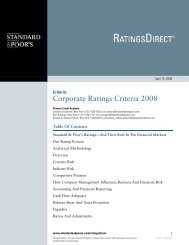European Infrastructure Finance Yearbook - Investing In Bonds ...
European Infrastructure Finance Yearbook - Investing In Bonds ...
European Infrastructure Finance Yearbook - Investing In Bonds ...
Create successful ePaper yourself
Turn your PDF publications into a flip-book with our unique Google optimized e-Paper software.
UTILITIES<br />
38 ■ NOVEMBER 2007<br />
Evolving political climate suggests long-term<br />
potential for increased nuclear generation<br />
The long-term outlook for significant nuclear<br />
construction is better today than it has been for<br />
many years. If the industry can overcome its<br />
unique problems of safety, decommissioning, and<br />
waste storage, and if political and social<br />
acceptance increases, a new generation of power<br />
plants could be built in the U.K. New build is<br />
currently being undertaken in France and Finland,<br />
with potential for new plants in the Baltic region<br />
and across a number of the Eastern <strong>European</strong><br />
member states. The German nuclear consensus,<br />
which caps the lifetime of nuclear plants at 32<br />
years and requires them to be phased out, could<br />
possibly be revisited, although the policies of<br />
Germany’s main political parties differ sharply on<br />
the question of nuclear power.<br />
Nuclear has a competitive advantage in terms<br />
of CO2 emissions and security-of-supply risk<br />
mitigation, and longer term visibility on the price<br />
of CO2 and the level of allowances that will be<br />
provided to fossil-fuel generators, for example,<br />
could have a strong impact on the profitability of<br />
new nuclear generation.<br />
Clean Coal And CCS Could Allow<br />
Coal-Heavy Economies To Meet<br />
Reduction Targets<br />
GHG reduction targets could present mediumterm<br />
credit risk to companies that are heavily<br />
exposed to coal-fired generation such as Drax<br />
Power Ltd. (BBB-/Stable/--). Larger, more<br />
diversified companies like CEZ a.s. (A-/Stable/--),<br />
Vattenfall, and RWE that also generate power<br />
using coal face increasing risk that the relative<br />
economics and social acceptance of coal-fired<br />
generation may deteriorate.<br />
Although liberalization and climate change<br />
policies favor gas-fired over coal-fired generation,<br />
the latter reduces fuel supply risk and dependence<br />
on fuel imports from Russia, the Middle East, and<br />
Africa. Recognizing this and the economic and<br />
social dependence of several EU countries on coal,<br />
the <strong>European</strong> Council has urged member states<br />
and the Commission to work toward<br />
strengthening R&D and developing the necessary<br />
technical, economic, and regulatory frameworks<br />
to deploy environmentally safe CCS through new<br />
fossil-fuelled power plants--if possible, by 2020.<br />
According to the EU, “coal can continue to make<br />
STANDARD & POOR’S EUROPEAN INFRASTRUCTURE FINANCE YEARBOOK<br />
its valuable contribution to the security of energy<br />
supply and the economy of both the EU and the<br />
world as a whole only with technologies allowing<br />
for drastic reduction of the carbon footprint of<br />
its combustion.”<br />
Policymakers and certain generators are<br />
therefore researching ways of making coal more<br />
efficient and environmentally friendly, primarily<br />
through “clean coal” technologies and CCS. RWE<br />
has made it clear that it will continue to build<br />
coal plants, but with the help of clean-coal<br />
technologies it will achieve CO2 reduction<br />
requirements. Vattenfall has similar plans.<br />
Cleaner coal is possible, but there are drawbacks<br />
The two leading clean-coal technologies are<br />
integrated gasification combined-cycle technology<br />
(IGCT) and supercritical technology. IGCT turns<br />
coal into gas (usually hydrogen and other byproducts)<br />
and then burns this gas in a traditional<br />
gas-fired combined-cycle unit (with some<br />
modification to accommodate the burning of<br />
hydrogen). Supercritical technology works on the<br />
principle that the fuel efficiency of a traditional<br />
steam coal plant can be raised if it operates at a<br />
higher temperature and pressure. Both approaches<br />
have drawbacks, however. Supercritical<br />
technology, although no more expensive than<br />
traditional techniques, does not reduce CO2<br />
emissions to anywhere near the levels of other<br />
fuels. And IGCT’s effectiveness comes at a cost,<br />
threatening the relative economics of coal<br />
production and reducing the incentive for<br />
companies to invest in new coal plants.<br />
CCS could enhance competitive position of coalfired<br />
generation, despite costs<br />
CCS involves capturing carbon and piping it<br />
underground before it reaches the atmosphere.<br />
The technology could significantly enhance the<br />
competitive position of coal-fired generation by<br />
alleviating its environmental impact, which would<br />
enable coal to maintain a role in the EU<br />
generation mix and would also mitigate securityof-supply<br />
risk. CCS has a number of<br />
disadvantages, however: Its use would increase<br />
costs, and its technical effectiveness and<br />
scalability is still unproven. Nevertheless,<br />
decarbonizing economies and industrial and<br />
generation processes clearly will not happen<br />
without cost and investment, and the EU and a



